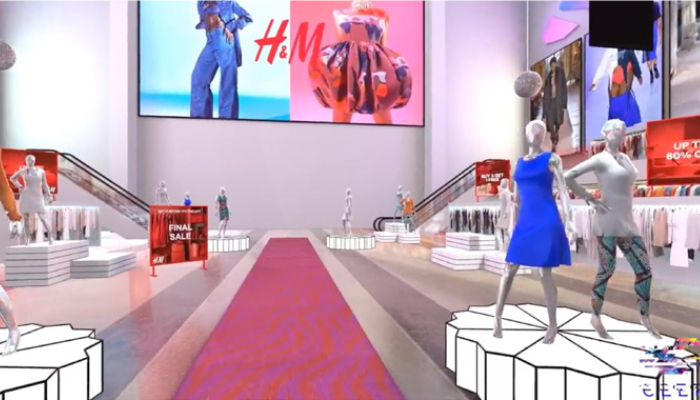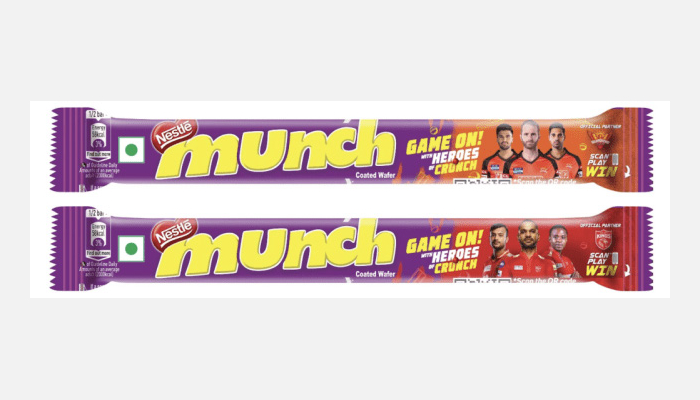
or

In today’s world, creative advertising is certainly a connecting point for all the brands across the globe. More so since consumers are not impressed with just the traditional entails of advertising anymore. Times are up for overflowing inboxes, Google ads, in other words, the ad fatigue has kicked in.
In 2022, the rage is all about the widely introduced virtual world metaverse. This is the state-of-the art way in which brands are thinking about engaging with existing and new customers. MUNCH, for instance partnered with 4 leading cricket franchises to create an experiential digital world for fans. It even came up with custom packaging featuring the players, which when scanned took users to a specially curated digital ecosystem of the brand in metaverse.
Currently, there are several metaverse platforms, each having a distinct look and feel, capabilities and possibilities. All these platforms are eventually anticipated to collaborate and form one big digital space.
Consequently, any brand, be it big or small, are putting their creative hats on and coming up with disruptive ideas ranging from social media challenges, campaigns, etc. to immerse in the global spirit of advertising.

While meta-advertising is indeed providing a refreshing take, and is anticipated to grow manifold, brands must not forget one crucial aspect- only the marketplace is virtual. The brand, their interactions and its consumers are all very real. As a result, while the promotional campaign could be virtual, but the claims ought to be real and authentic.
The Indian Government has echoed this with its recent noteworthy move of notifying the Central Consumer Protection Authority (‘Guidelines’ for Prevention of Misleading Advertisements and Endorsements for Misleading Advertisements, 2022). The Guidelines are applicable to advertisements published on all mediums, be it print, television and online.
Having said that, one must be mindful of the fact that misleading advertisements are frowned upon alike, regardless of the medium, which indeed includes metaverse.
In light of the foregoing, this article provides a snapshot of how meta-advertisers could be in compliance with the current legal regime, to avoid coming under the radar of severe ramifications and bad repute.
The Central Consumer Protection Authority (CCPA) panel, under its authority to oversee consumer protection, came up with the Guidelines w.e.f. June 9, 2022, which comprehensively covers not only bait advertising, surrogate advertising, puffery and brand endorsers’ liability, but also imitation advertising.
It requires proper due diligence by brand ambassadors and endorsers, manufacturers, service providers and stipulates heavy fines and even jail terms for misleading claims. In case of violation of these Guidelines, penalties stipulate from INR 10 to 50 lakh. The Guidelines also give teeth to the enforcement of several parameters contained in the ‘Code for Self-Regulation in Advertising’ (ASCI Code) issued by the self-regulating body Advertising Standards Council of India. The advertising watchdog has emphasised time and again that the way forward for safeguarding involves a bimodal strategy – focusing on both offline and online business streams.

In practice, a misleading claim could involve any such ad or intent of a stakeholder, which fools the consumer into believing that they could get a better deal, then what is offered in reality. For instance, in the Bored Ape Yacht Club Phishing Attack on metaverse, the scam rooted from a misleading advertisement, which required users to connect their MetaMask wallets to use it on the site.
In fact, according to an investigation conducted by the non-profit US advertising watchdog Truthinadvertising.org (TINA.org), brands and their influencers are taking advantage of the improper Meta Guidelines to trick millions of consumers into unwittingly take part in branded worlds (also known as advergames), interacting with covert avatar influencers and AI-controlled promotional bots, and spending a significant amount of time and money on them.
Consider the following Roblox search results for activities inspired by the Netflix series “Stranger Things.” Which of these experiences, if any, are sponsored is not at all evident?
The risk with making allegedly false claims is not just confined to consumer litigation or regulatory scrutiny, but also from a potential competitor. Hence, in web 3.0, brands need to consider not just the two-dimensional, but the three-dimensional, auditory and/or performance claims that might be made by a particular advertisement and must ensure the accuracy of the claims along with its substantiation.
Influencer marketing is one notch above word-of-mouth marketing. It could be important in engaging consumers in meta communities, and the metaverse is already driving some impressive results for big brands like Nike, Vans, Hyundai and Forever 21, et al.
In context of the digital world, virtual influencers are defined as fictional computer-generated ‘people’ or ‘avatars’ who have realistic characteristics, features, and personalities of humans and behave in a similar manner as influencers. These influencer’s avatars look and act like any other avatar you might run into on meta land, but these avatars, controlled by paid brand influencers are placed to promote brands throughout the metaverse.
This basically means that without ever knowing, there are potentially millions of players seeing, communicating, and interacting with brand endorsers.
In another instance, an undisclosed Nike avatar influencer was complimented on his Nike gear by another player while in Nikeland, oblivious of the fact that the avatar is a virtual paid promoter, luring the player into buying the impressive gear.
This indeed raises concern and calls for appropriate disclosures. Social media users are accustomed to seeing influencers adding disclaimers in their posts when collaborating with a sponsor or endorsing a good or service. Similarly, influencers in the metaverse must also be subject to such disclosures. This also includes virtual influencers, who must disclaim that they are not real people.
While metaverse is a fairly new concept, there are a handful of celebrities and influencers who are already setting up their brand in the virtual world. Like the famous Indian singer Daler Mehndi has become the first man to buy land in metaverse, named the Balle Balle Land, and has already hosted a musical concert.
Similarly, in the MUNCH campaign, where 4 leading cricket franchises were taken on board to create an experiential digital world, fans were given a chance to enter the metaverse and interact with their favourite cricketers, meet the avatars of cricket players, speak with them and even click pictures together
Any celebrity endorser regardless of the advertising medium, must be mindful that promotional material that carries a social influence or representation needs a proactive measure in the form of due diligence, accountability and good governance.
Further, the endorsement in an advertisement should not be deceptive, and should reflect the genuine, reasonably current opinion of the individual making such representation and be based on adequate information about or experience with the identified products/services. The self-regulatory watchdog, ASCI also has ‘Guidelines for Celebrities in Advertising’ in place, emphasising on such diligence by an endorser.
Another issue that stems from having famous endorser avatars on board is the personality and privacy right concern. Just like in the real world, it is imperative to have due consent, authorization and agreements in place before onboarding any celebrity endorser for commercial purposes, even though it may be for a digital avatar.
The ability to purchase, own, and resell digital assets, a feature made possible by the advent of blockchain technology, is one of the things that presently distinguishes the metaverse from other social networking platforms.
While dealing in the unregulated virtual currency is inevitable in meta world, but Guidelines for advertising of VDA’s formulated by the ASCI is crystal clear. For instance, according to the Guidelines, any advertisements for VDA goods, exchanges, or display must include the warning that “Crypto products and NFTs are unregulated and can be highly risky. There may be no regulatory recourse for any loss from such transactions.”
Hence, it seems only prudent to imbibe these Guidelines while promoting VDA’s in all the mediums alike.
Metaverse is fundamentally a three-dimensional internet that enables people to move between real and virtual world. Consider a customer browsing beers in a virtual beer store, picking up cans, looking at labels, flipping the can over to learn about origin, and then making a purchase to have it delivered to their house in real world.
This basically means that even the three-dimensional virtual product must comply with all the applicable labelling regulations. For instance, Rule 10 of the Legal Metrology Act, 2009, requires ecommerce entities to display certain declarations as printed on the label of a packaged commodity, on the digital and electronic network.
In the meantime, companies should make an effort to replicate the compliant labels found on physical products on virtual representations of products in the metaverse until more information is available on whether and how these regulations apply to virtual displays.
Have you ever noticed something odd about the commercials for alcohol and tobacco? They never really promote themselves as one. This is where surrogate advertising comes into play. For instance, you must have noticed famous brands, covertly promoting, mouthwash, water, and even friendship, and yet are able to connect the consumers with the inherently prohibited product.
A ban on such surrogate advertisements has been imposed via the Guidelines issued by Consumer Affairs Ministry. Brands have made considerable use of social media and digital channels for advertising, despite limits on alcoholic beverage advertisements on mainstream routes. With the statutory ban, it would be interesting to see how the prohibited brands play around the restrictions in the digital space.

Compliance in the metaverse over prohibited advertising to minors can be a little challenging, owing to lack of accurate mechanism to filter demographic data.
Particularly in the case of VDAs, junk food, etc. brands, distributors, and retailers will need to discover sources to determine with certainty that the metaverse platforms or events where they are advertising do not appeal to an underage group. For instance, entering the Heineken store in metaverse, requires age permit first. Virtual bouncers have been placed to ensure this. Any advertisement addressing or targeting or using children shall have to comply with a host of conditions set out in the Guidelines notified by the Government, as well as the ASCI.
Brands may be able to see a 3D avatar representation of your identity in the metaverse. Does the avatar, however, signify express consent? Can marketers target adverts based on a person’s appearance in virtual reality? While, these questions remain unresolved, it is imperative to address considerations such as whether or not such data can be shared by influencers, how new privacy laws impact the overall data privacy analysis etc. Engaging with influencers internationally means considering country-wise data privacy compliances and obligations. Terms of use on third party platforms may include restrictions on how certain data can be put out or monetised.
Given the obvious excitement that brands share about connecting with their audience in new and engaging ways, brands must keep in mind that consumers cannot be deceived in any way, regardless of the medium.
The ASCI’s well-established guidelines along with the CCPA’s statutory backing, controlling deceptive advertising will certainly be applicable in metaverse. Brands operating in the metaverse will need to take the context of the new medium into consideration to determine whether a disclosure is clear and prominent to make sure that no consumer is deceived.

While the mechanisms of disclosure could probably differ in the metaverse, but the intent of clear disclosure to encourage transparency must certainly be adopted. For starters, one must ensure to disclose/ensure:
False and misleading claims or irresponsible endorsements have consequences, with more serious civil and criminal consequences for celebrities and endorsers especially in today’s culturally sensitive environment where consumers are extremely vigilant of their rights.
Consequently, regardless of the interaction taking place inside a brick and mortar, televisions, radios and now metaverse, the brands need to be mindful of their advertising strategies not only from a promotional aspect, but also from the perspective of being honest and transparent.
Mohit Goel is a Partner at Sim And San. Mohit’s expertise extends to dispute resolution in the field of Intellectual Property Rights and Arbitration and Conciliation. Mohit has played and continues to play a key role in some of India’s biggest Intellectual Property disputes. Mohit is also an active member of the International Trademark Association (INTA).
Mehr Bajaj is an Associate with Sim and San. She comes with a flavoured experience in the field of IPR. She renders opinions on Trade Mark, Advertising, Design and Copyright Law.

Lex Witness Bureau

Lex Witness Bureau

Lex Witness Bureau

For over 10 years, since its inception in 2009 as a monthly, Lex Witness has become India’s most credible platform for the legal luminaries to opine, comment and share their views. more...
Connect Us:


The Grand Masters - A Corporate Counsel Legal Best Practices Summit Series
www.grandmasters.in | 8 Years & Counting
The Real Estate & Construction Legal Summit
www.rcls.in | 8 Years & Counting
The Information Technology Legal Summit
www.itlegalsummit.com | 8 Years & Counting
The Banking & Finance Legal Summit
www.bfls.in | 8 Years & Counting
The Media, Advertising and Entertainment Legal Summit
www.maels.in | 8 Years & Counting
The Pharma Legal & Compliance Summit
www.plcs.co.in | 8 Years & Counting
We at Lex Witness strategically assist firms in reaching out to the relevant audience sets through various knowledge sharing initiatives. Here are some more info decks for you to know us better.
Copyright © 2020 Lex Witness - India's 1st Magazine on Legal & Corporate Affairs Rights of Admission Reserved